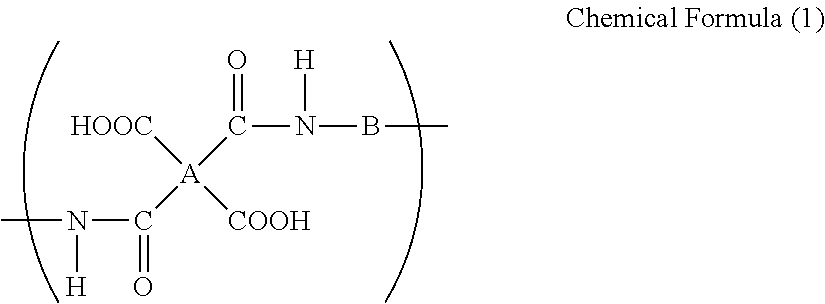Binder resin composition for electrode, electrode mixture paste, and electrode
- Summary
- Abstract
- Description
- Claims
- Application Information
AI Technical Summary
Benefits of technology
Problems solved by technology
Method used
Image
Examples
example 1
[0096]To a glass reaction vessel with internal volume of 500 mL that is equipped with a stirrer and an inlet • outlet for nitrogen gas, 400 g of NMP was added as a solvent. To the solvent, 25.85 g (0.239 mol) of PPD and 74.15 g (0.239 mol) of OPDA were added and the mixture was stirred for 10 hours at 50° C. to obtain a binder resin composition for an electrode which has a solid matter content of 18.1% by mass, solution viscosity of 4.9 Pa·s, and inherent viscosity of 0.75.
[0097]The binder resin composition for an electrode which has been obtained from the above was coated on a glass plate substrate by using a bar coater. The coated film was de-foamed and pre-dried under reduced pressure for 30 minutes at 25° C., and was then placed in a hot air dryer in nitrogen gas atmosphere under atmospheric pressure and heated for 30 minutes at 120° C., 10 minutes at 150° C., 10 minutes at 200° C., 10 minutes at 250° C., and 10 minutes at 400° C. to form a binder resin film having a thickness o...
example 2
[0100]To a glass reaction vessel with internal volume of 500 mL that is equipped with a stirrer and an inlet • outlet for nitrogen gas, 400 g of NMP was added as a solvent. To the solvent, 39.23 g (0.196 mol) of ODA and 60.77 g (0.196 mol) of OPDA were added and the mixture was stirred for 10 hours at 50° C. to obtain a binder resin composition for an electrode which has a solid matter content of 18.3% by mass, solution viscosity of 5.2 Pa·s, and inherent viscosity of 0.78.
[0101]The binder resin composition for an electrode which has been obtained from the above was coated on a glass plate substrate by using a bar coater. The coated film was de-foamed and pre-dried under reduced pressure for 30 minutes at 25° C., and was then placed in a hot air dryer in nitrogen gas atmosphere under atmospheric pressure and heated for 30 minutes at 120° C., 10 minutes at 150° C., 10 minutes at 200° C., 10 minutes at 250° C., and 10 minutes at 350° C. to form a binder resin film having a thickness o...
example 3
[0104]To a glass reaction vessel with internal volume of 500 mL that is equipped with a stirrer and an inlet • outlet for nitrogen gas, 400 g of NMP was added as a solvent. To the solvent, 56.96 g (0.139 mol) of BAPP and 43.04 g (0.139 mol) of ODPA were added and the mixture was stirred for 10 hours at 50° C. to obtain a binder resin composition for an electrode which has a solid matter content of 18.5% by mass, solution viscosity of 5.0 Pa·s, and inherent viscosity of 0.74.
[0105]The binder resin composition for an electrode which has been obtained from the above was coated on a glass plate substrate by using a bar coater. The coated film was de-foamed and pre-dried under reduced pressure for 30 minutes at 25° C., and then placed in a hot air dryer in nitrogen gas atmosphere under atmospheric pressure and heated for 30 minutes at 120° C., 10 minutes at 150° C., 10 minutes at 200° C., 10 minutes at 250° C., and 10 minutes at 350° C. to form a binder resin film having a thickness of 5...
PUM
| Property | Measurement | Unit |
|---|---|---|
| Temperature | aaaaa | aaaaa |
| Temperature | aaaaa | aaaaa |
| Fraction | aaaaa | aaaaa |
Abstract
Description
Claims
Application Information
 Login to View More
Login to View More - R&D
- Intellectual Property
- Life Sciences
- Materials
- Tech Scout
- Unparalleled Data Quality
- Higher Quality Content
- 60% Fewer Hallucinations
Browse by: Latest US Patents, China's latest patents, Technical Efficacy Thesaurus, Application Domain, Technology Topic, Popular Technical Reports.
© 2025 PatSnap. All rights reserved.Legal|Privacy policy|Modern Slavery Act Transparency Statement|Sitemap|About US| Contact US: help@patsnap.com



